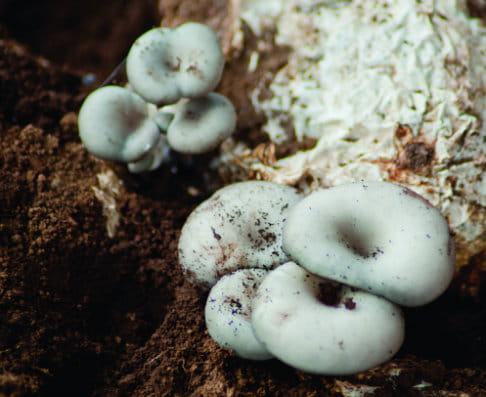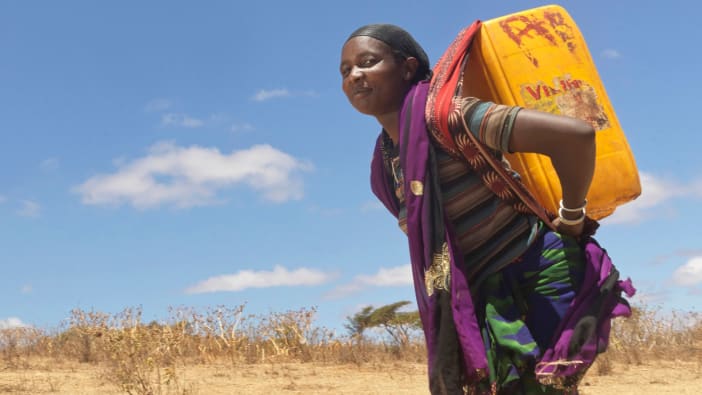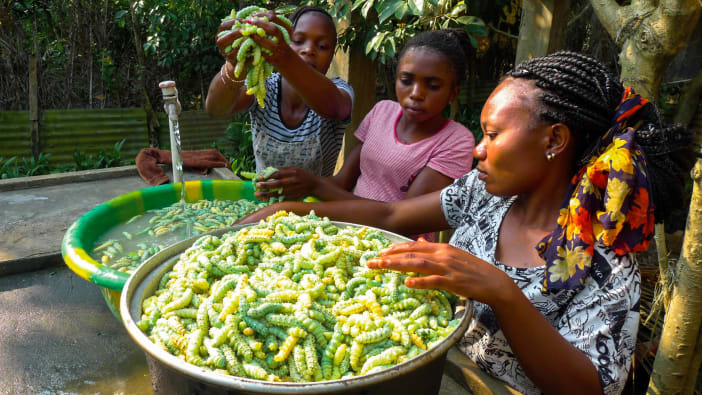Mushroom growing can be a useful way of earning income when climate change makes farming less reliable. They can also be used as extra food for the family. They grow quickly and are rich in protein, vitamins and minerals. You do not need farmland to grow mushrooms, so it is a useful activity in both rural and urban areas.
There are several ways of growing mushrooms. They can grow in plastic bags, in pots, on logs or on wooden trays arranged in stacks – anywhere where light levels, temperature and water can be controlled. A simple building can provide controlled growing conditions. The growing cycle takes between one and three months. If possible, get advice from someone with good experience before starting.
There are many edible mushroom species and each grows best in a particular growing medium. However, some species can grow on a wide range of materials. The growing medium can be prepared from materials such as rice straw, rice bran, banana leaves, sawdust and logs (see box). The easiest types of mushroom to grow in hot areas are oyster, volvariella and maitake.
Choose a growing medium that is easy to obtain. It needs to be chopped up, soaked under water for several days (to kill insects) and then dried and mixed with some lime and fertiliser. Ideally it should be sterilised by steaming. You can use a 44-gallon drum or similar container to make a steriliser. Modify the container so that the growing medium is held at the top, and boil some water at the bottom.
Then place the growing medium into containers and add the mushroom spawn.
PLEASE NOTE: Mushroom spawn is best produced in special sterile conditions. You will probably need to buy spawn from a specialist supplier. You can research local suppliers using the internet, or by asking community members, universities or NGOs.
After it is placed in the growing medium, the spawn will produce something called mycelium. This looks like white fibres, and will take about 10 days to spread through the growing medium. The mycelium will begin to produce mushrooms. These usually grow in batches every few days. Once mushroom production really slows down after two or three months, you can start the process again. Use the old growing medium as compost or fertiliser for other crops.
Key steps
1. Identify and clean a building or containers where the temperature, light level and moisture can be controlled.
2. Choose and prepare the growing medium.
3. Sterilise the medium.
4. Seed the growing medium bags or beds with spawn.
5. Maintain the correct temperature, moisture, hygiene and lighting. These will differ between species.
6. Harvest, process, package and sell the mushrooms.
7. Clean the growing area and begin again with fresh growing medium and spawn.
Mushrooms are delicate. Harvest them with a sharp knife and place them in baskets or boxes to transport them. If you have mushrooms left over, they can be dried and stored for future use.
Ideally, buy new spawn each time you start the process. However, if this is difficult or expensive, you can keep back some of the older growing medium and use the spawn from this on new medium.
For more information see CTA’s Agrodoks 40 and 41. Visit http://publications.cta.int and type ‘mushroom’ into the search box.
See also Practical Action’s technical brief: www.practicalaction.org/mushroom-growing
PLEASE NOTE: Some varieties of mushrooms can be poisonous. It is important to get expert advice before beginning a mushroom project.










